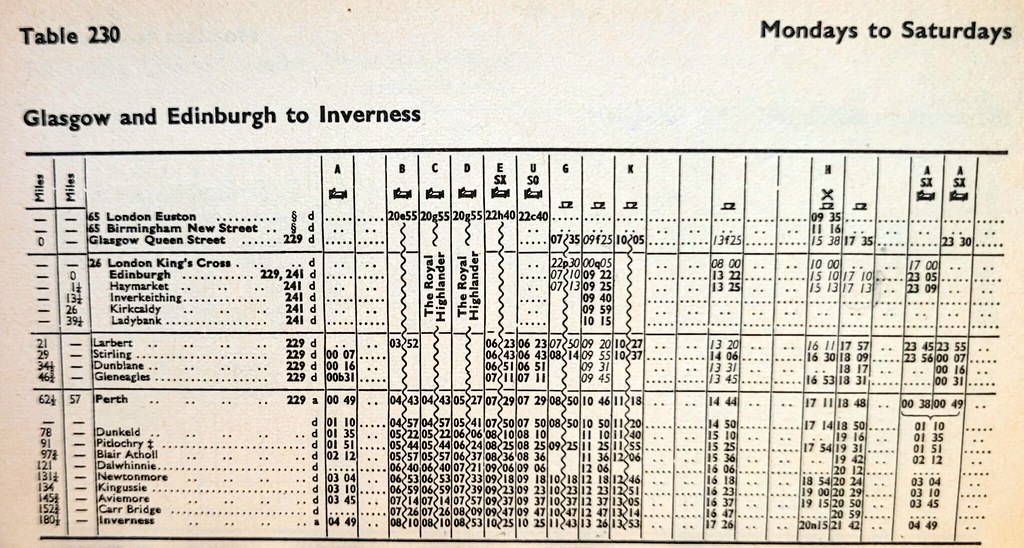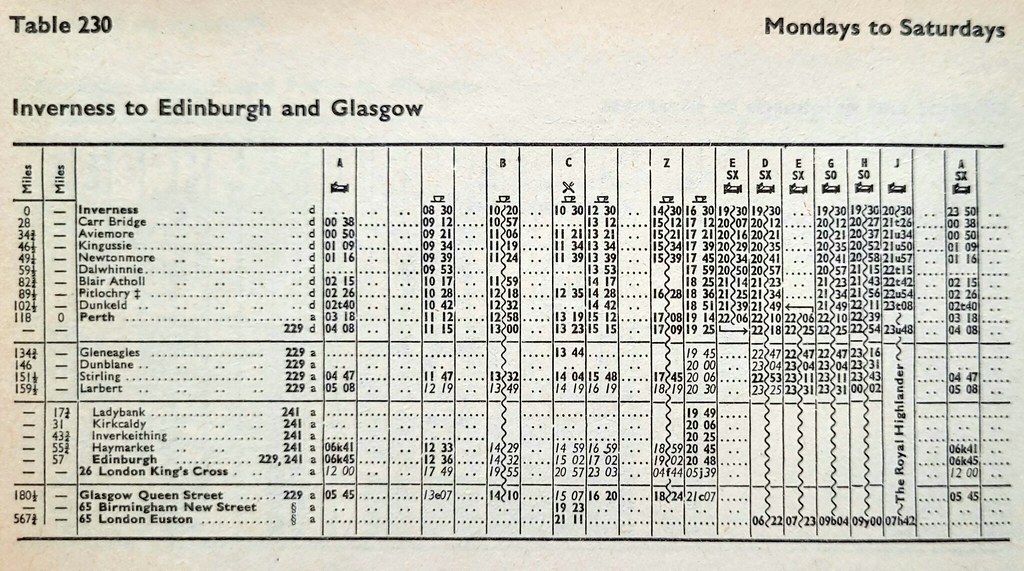thenorthern
Established Member
- Joined
- 27 May 2013
- Messages
- 4,119
One thing to remember is the numbers of stations since the 1950s has declined dramatically although the number of services running has increased by quite a bit.
I meant to link to this earlier, but things hadn't improved hugely even 8 years later (and would be similar until at least 1987 which is I believe when the seasonal services became permanent and lasted through the winter).Inverness is perhaps worth a mention here. Until the introduction of the Clansman in 1974 there were just three daytime train to the Central Belt, 08.20 to Edinburgh, 11.25 to Glasgow and 16.35 with portions for both. Although the Royal Highlander departed relatively early at 19.00 there were no connections beyond Stirling. In the same period the service to Aberdeen had (I think fairly recently) been increased from five to six trains per day. A far cry from more recent service levels on both routes.


Between 1975 and 1991 Markinch appeared in the PTT as Markinch for Glenrothes.Glenrothes in Fife - one of Scotland's five post-war new towns and the administrative centre of Fife Region, with a population of nearly 40,000 - didn't even have a station until may 1992 when Glenrothes with Thornton opened. In practical terms, the nearest staion was - and still is - Markinch, although some of the Western parts of the town may be nearer to Cardenden which, for many years in the 1970s and 1980s was only served in the morning and evening peak hours Mondays-Fridays.
I think that most of the "New Towns" initially ignored any provision for a railway station. Think Milton Keynes, for example.
And Harlow, where although a station was provided, at Harlow Town, it is right on one edge of the New Town and therefore a long way from many parts of it ! Although perhaps the county boundary being just behind the railway was a factor there ?
But it is a good question as to why the centre of Harlow New Town was built so far away from the railway. It is a long walk, a similar distance to Cambridge.
This was a feature of typical New Town design, they were seen (by their designers) as wholly self-contained "islands", houses, shops, factories, all within the town. No need to go outside. There was an equivalent aspect of their road design, which commonly facilitated journeys within the town but needed inconvenient dog-legs to get outside. The wall maps of the towns in their Development Commission offices would be drawn in complete isolation - one would have thought it was a map of the Isle of Man.But it is a good question as to why the centre of Harlow New Town was built so far away from the railway.
Thanks. And Stevenage is an interesting contrast. At Stevenage the new town centre is close to the railway, yet it only got a New Town station in 1973.This was a feature of typical New Town design, they were seen (by their designers) as wholly self-contained "islands", houses, shops, factories, all within the town. No need to go outside. There was an equivalent aspect of their road design, which commonly facilitated journeys within the town but needed inconvenient dog-legs to get outside. The wall maps of the towns in their Development Commission offices would be drawn in complete isolation - one would have thought it was a map of the Isle of Man.
Haverfordwest is certainly a strategically important town in West Wales, but it's not all that large is it? Population maybe 11,000.What about Haverfordwest and Tenby? The main towns in Pembrokeshire and mainly only a two hourly service even in the tourist season.
Haverfordwest is certainly a strategically important town in West Wales, but it's not all that large is it? Population maybe 11,000.
Think it is actually Haverfordwest that is the county town of Pembrokeshire.I suspect Pembroke is the actual county town.
Think it is actually Haverfordwest that is the county town of Pembrokeshire.
HSTs west of Carmarthen have been confined to the summer Saturday Tenby/Pembroke train for years, plus ISTR the odd Fishguard at one time. (These had previously been loco hauled, and there was also a York-Tenby on Saturdays for some summers.)Service then was also about every 2 hours, but by 2-car first-gen DMU (not a 117 as I would expect, but something else, perhaps a 108?) There were also 1 or 2 HSTs to and from London, up in the morning, down in the evening, not sure if these still exist?
The Swindon 120 dmus were indeed ubiquitous west of Swansea, from their introduction in the late 1950s until their withdrawl and replacement by a hotch-potch of low density cars from other regions, but I also recall a surprising number of services, seemingly oddball ones to no apparent pattern, with short formations of loco-hauled stock and Hymek Class 35s, at least until their end in the mid-1970s, and then with Class 47s, of which there were always a substantial and indeed surprising number west of Carmarthen used on the oil trains and various other duties, or even just standing in a siding at odd places like Whitland. I don't think the dmus got to Fishguard very much. It was actually an approach you found all across the rest of the Western Region as well.HSTs west of Carmarthen have been confined to the summer Saturday Tenby/Pembroke train for years, plus ISTR the odd Fishguard at one time. (These had previously been loco hauled, and there was also a York-Tenby on Saturdays for some summers.)
From the time through London portions of expresses were withdrawn in the (late?) 60s, trains beyond Swansea were almost all DMU as you say (Swindon 120s were used at least into the 70s), with almost nothing working further east. The exceptions were the sleeper/postal/parcels trains, 2 each way (one Bristol one London) IIRC, and at some time the passenger stock of these was used to work back to Carmarthen or Swansea.
HSTs west of Carmarthen have been confined to the summer Saturday Tenby/Pembroke train for years, plus ISTR the odd Fishguard at one time. (These had previously been loco hauled, and there was also a York-Tenby on Saturdays for some summers.)
From the time through London portions of expresses were withdrawn in the (late?) 60s, trains beyond Swansea were almost all DMU as you say (Swindon 120s were used at least into the 70s), with almost nothing working further east. The exceptions were the sleeper/postal/parcels trains, 2 each way (one Bristol one London) IIRC, and at some time the passenger stock of these was used to work back to Carmarthen or Swansea.
The Swindon 120 dmus were indeed ubiquitous west of Swansea, from their introduction in the late 1950s until their withdrawl and replacement by a hotch-potch of low density cars from other regions, but I also recall a surprising number of services, seemingly oddball ones to no apparent pattern, with short formations of loco-hauled stock and Hymek Class 35s, at least until their end in the mid-1970s, and then with Class 47s, of which there were always a substantial and indeed surprising number west of Carmarthen used on the oil trains and various other duties, or even just standing in a siding at odd places like Whitland. I don't think the dmus got to Fishguard very much. It was actually an approach you found all across the rest of the Western Region as well.
Yes, possibly more than the couple I mentioned which were Milford-Carmarthen and v.v.I also recall a surprising number of services, seemingly oddball ones to no apparent pattern, with short formations of loco-hauled stock and Hymek Class 35s, at least until their end in the mid-1970s, and then with Class 47s...
The 1970 WTT on Timetableworld has a 2005 ex Swansea and 0800 return - among other delights the down train, and all others 2100-0500, had to reverse twice to serve Carmarthen as Carmarthen Bridge box, and therefore the west curve, was closed on nights as an economy measure. We sometimes forget how restricted services could be back then.I don't think the dmus got to Fishguard very much.
There'll be worse, but Bicester wasn't great either. 1977-82 era was three trains on weekdays between the 0905 and 1713 arrivals from London, stopping at all stations from South Ruislip (90 minutes for 55 miles).
On Sundays there were two trains departing London between the 0820 and 1738, roughly a train every three hours.
Believe the population of Bicester was just over 4,000 in 1951 and maybe 12,500 in 1971.I guess Bicester was a relatively small market town in a pretty rural area, so perhaps a two-hourly service wasn't too bad. Isn't it relatively recently (since the coming of the M40?) that Bicester has grown?
Believe the population of Bicester was just over 4,000 in 1951 and maybe 12,500 in 1971.
The M40 opened in 1991 and now the population is something like 32,500.
Not sure if there's any direct causality, but it's certainly a good working theory.
Class 37 ( usually from boiler-fitted batch 37175 - 37192) also worked passenger services west of Swansea in the 1970s and early 1980s)The Swindon 120 dmus were indeed ubiquitous west of Swansea, from their introduction in the late 1950s until their withdrawl and replacement by a hotch-potch of low density cars from other regions, but I also recall a surprising number of services, seemingly oddball ones to no apparent pattern, with short formations of loco-hauled stock and Hymek Class 35s, at least until their end in the mid-1970s, and then with Class 47s, of which there were always a substantial and indeed surprising number west of Carmarthen used on the oil trains and various other duties, or even just standing in a siding at odd places like Whitland. I don't think the dmus got to Fishguard very much. It was actually an approach you found all across the rest of the Western Region as well.
And some 33s too in the early 1980s.Class 37 ( usually from boiler-fitted batch 37175 - 37192) also worked passenger services west of Swansea in the 1970s and early 1980s)
